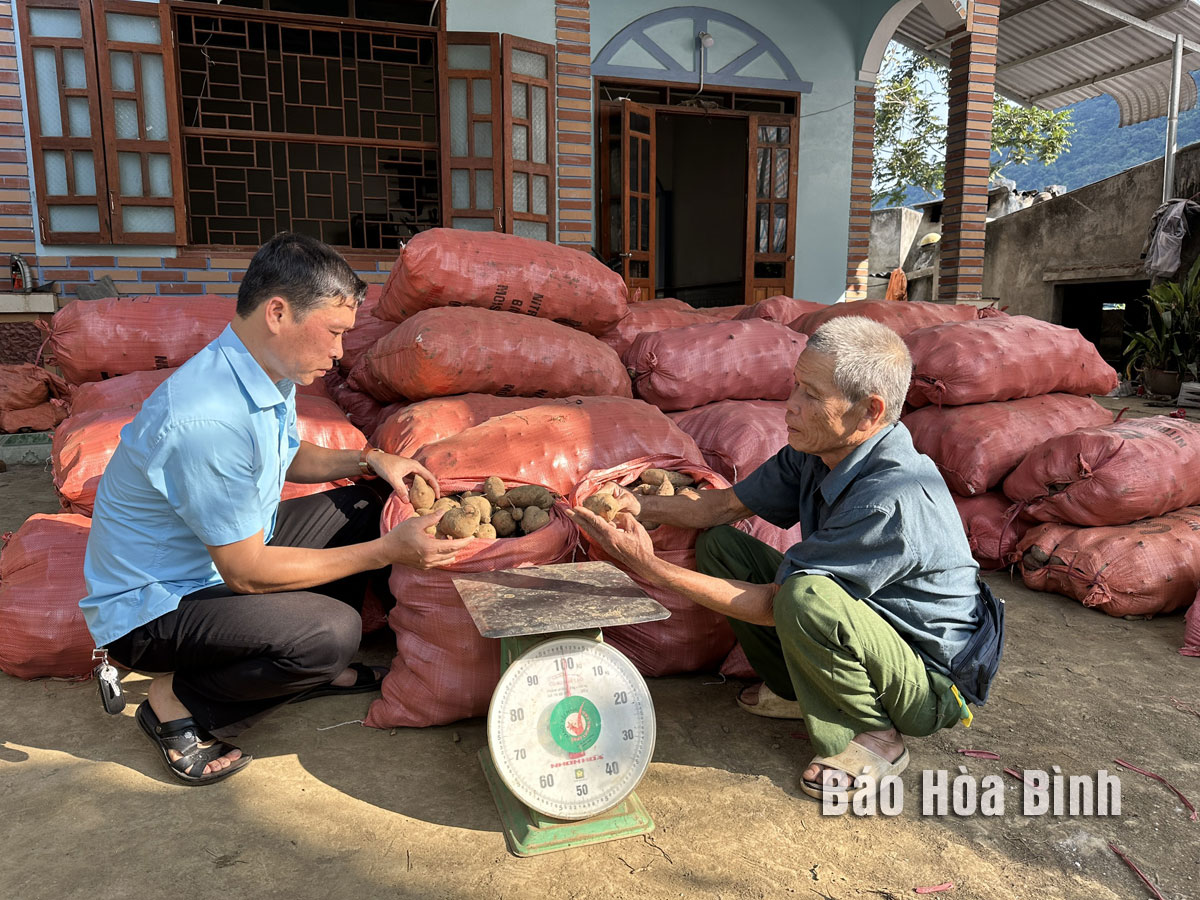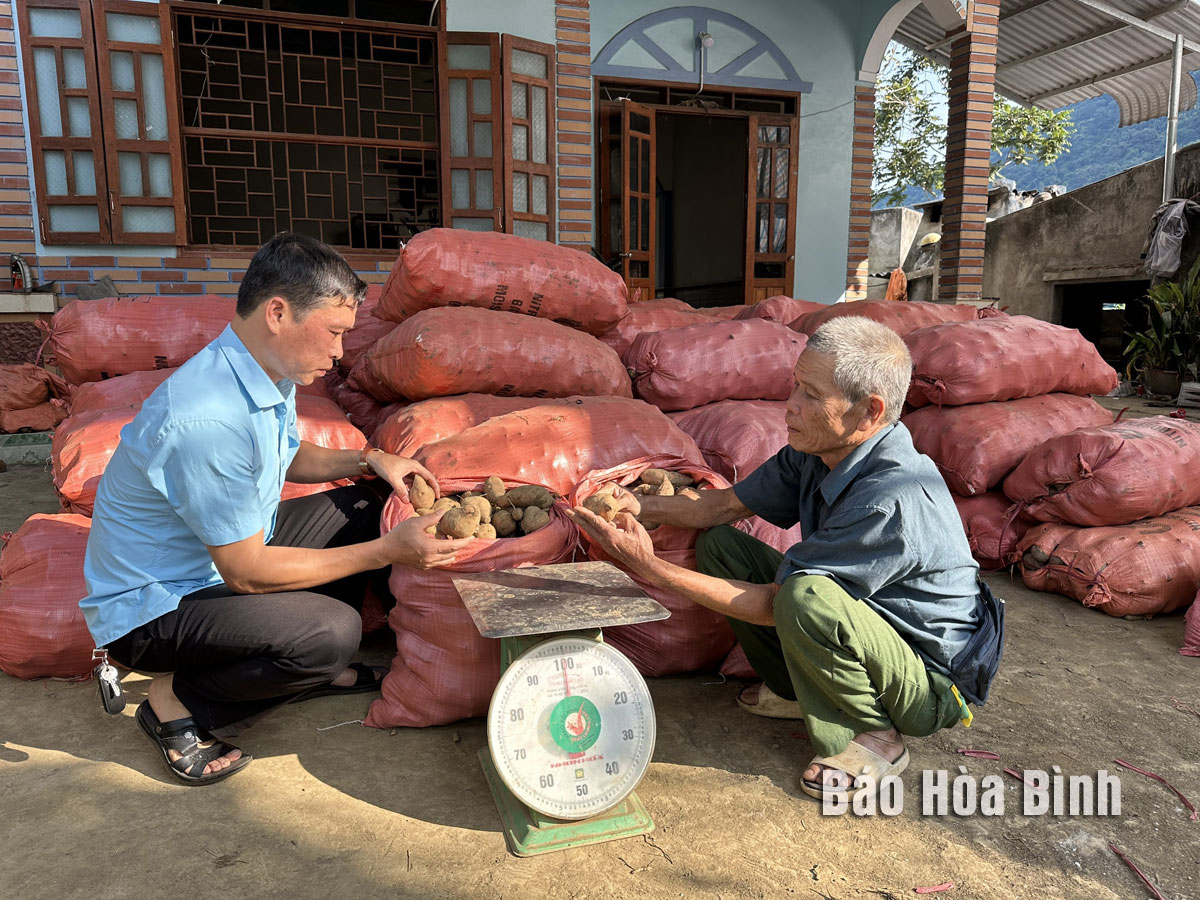
The One Commune One Product (OCOP) programme has helped encourage active labour among farmers, increasing production and creating high-quality products. In response to the programme, farmers in Phu Cuong commune, Tan Lac district, are working on their local sweet potato branding and forming a concentrated production area for better income and economic development.
Sang Tho, from Phu Cuong’s Vo hamlet,
harvests sweet potato.
Capitalising on its available idle and sandy
soil, suitable for sweet potato cultivation, Phu Cuong has been making efforts
to form a concentrated production area for the plant.
Vo hamlet is home to 140 households with over
700 residents, and nearly all of them have areas for sweet potato farming.
Notably, Sang Tho's household is currently growing over 3,000m2 of the plant.
Tho said this year, sweet potato has thrived as there are fewer pest and
disease issues. Phu Cuong sweet potato is an indigenous variety with a
distinctive sweet and aromatic flavour. Its cultivation is relatively simple;
with proper care, a yield of about 3 - 5 tonnes per hectare can be achieved.
Bui Van Thanh's household, meanwhile, has a
relatively large plantation area of over 4,000m2. Their sweet potato is
purchased by traders from various locations. Thanh said the price of sweet
potato is relatively stable compared to other farm produce. However, the
current capital is still limited, and there is no capacity for investment in
the diversification of production and processing. Therefore, only raw products
are available, resulting in lower selling prices.
"With a good harvest, the sweet potato garden
has generated over 90 million VND (3,722 USD) for my family since the beginning
of this year,” Thanh said.
The sweet potato of Phu Cuong have been
registered for the OCOP programme, with the commune aiming at quality improvement,
OCOP branding, favourable conditions for product consumption, and supply chain
formation serving better productivity and income. To this end, it is actively
forming cooperatives and cooperative groups for sweet potato cultivation,
creating a brand for the root, and supporting participating households in
production, disease prevention, and e-commercial application.
Bui Duc Phuong, Chairman of the People's
Committee of Phu Cuong Commune, said sweet potato is an important agricultural
product of the locality, attracting many traders from in and outside the
province. In the coming time, Phu Cuong will focus on regional planning for
standardised production to process sweet potato into a high-quality OCOP
product, supplying the domestic market and opening up possibilities for
export.
According to data from the Hoa Binh Provincial Party Committee, the industrial production index for the first six months of 2025 is estimated to have increased by 20% compared to the same period last year. This marks the highest year-on-year growth rate for this period since 2020.
In the first six months of 2025, Hoa Binh province’s export turnover was estimated at 1.145 billion USD, marking an 18.11% increase compared to the same period in 2024. Import turnover was estimated at $ 804 million, a 17.15% increase, which helped the province maintain a positive trade balance.
The lives of the ethnic minority farmers in Tan Lac district have gradually improved thanks to the new directions in agricultural production. This is a testament to the collective strength fostered through the professional associations and groups implemented by various levels of the district’s Farmers’ Union.
With the motto the "product quality comes first,” after nearly one year of establishment and operation, Muong village’s Clean Food Agricultural and Commercial Cooperative, located in Cau Hamlet, Hung Son Commune (Kim Boi district), has launched reputable, high-quality agricultural products to the market that are well-received by consumers. The products such as Muong village’s pork sausage, salt-cured chicken, and salt-cured pork hocks have gradually carved out a place in the market and they are on the path to obtaining the OCOP certification.
In the past, the phrase "bumper harvest, rock-bottom prices" was a familiar refrain for Vietnamese farmers engaged in fragmented, small-scale agriculture. But today, a new spirit is emerging across rural areas of Hoa Binh province - one of collaboration, organisation, and collective economic models that provide a stable foundation for production.
Maintaining growing area codes and packing facility codes in accordance with regulations is a mandatory requirement for agricultural products to be eligible for export. Recently, the Department of Agriculture and Environment of Hoa Binh province has intensified technical supervision of designated farming areas and packing facilities to safeguard the "green passport" that enables its products to access international markets.



